SCERT AP 7th Class Science Study Material Pdf 9th Lesson Heat, Temperature and Climate Textbook Questions and Answers.
AP State Syllabus 7th Class Science 9th Lesson Questions and Answers Heat, Temperature and Climate
7th Class Science 9th Lesson Heat, Temperature and Climate Textbook Questions and Answers
Improve Your Learning
I. Fill in the blanks.
1. Doctor uses ______ thermometer to measure the human body temperature.
2. The best liquid for a thermometer is _____
3. The force applied by air on any surface in contact is called ______
4. The average weather pattern taken over a long time is called the _____ of the place
5. The amount of water vapour present in the air is called _____
Answer:
1. clinical
2. mercury
3. air pressure
4. climate
5. humidity
II. Choose the correct answer.
1. A student observe day-to-day conditions of the atmosphere on three consecutive days and recorded his observations. She wants to show the data using a graph. Which graph is suitable for her?
a) climate graph
b) weather graph
c) temperature
d) humidity graph
Answer:
b) weather graph
2. Conduction of heat takes place in
a) metals
b) liquids
c) gases
d) air
Answer:
a) metals
3. Average human body temperature is
a) 0°C
b) 20°C
c) 37°C
d) 100°C
Answer:
c) 37°C
![]()
4. Number of divisions in Fahrenheit scale
a) 180
b) 100
c) 50
d) 200
Answer:
a) 180
III. Matching.
| A) Melting point of ice | 1. mercury |
| B) Precipitate | 2. barometer |
| C) Air pressure | 3. 100°C |
| D) Boiling point of water | 4. 0°C |
| E) Metal used in thermometer | 5. rain gauge |
| 6. alcohol |
Answer:
| A) Melting point of ice | 4. 0°C |
| B) Precipitate | 5. rain gauge |
| C) Air pressure | 2. barometer |
| D) Boiling point of water | 3. 100°C |
| E) Metal used in thermometer | 1. mercury |
IV. Answer the following questions.
Questions 1.
What are similarities and differences between the laboratory thermometer and the clinical thermometer?
Answer:
| Laboratory thermometer | Clinical thermometer |
| Differences: | |
| 1. Laboratory Thermometer is used in school labs, industries etc. to measure temperature. | 1. Clinical Thermometer is used in hospitals to measure the temperature of the human body. |
| 2. It has nd kink that prevents the mercury from flowing back into the bulb. | 2. It has a kink that prevents the mercury from flowing back into the bulb. |
| 3. Level of liquid may rise or fall after taking reading. | 3. Level of liquid not changes after taking reading. |
| 4. It has reading from -10 to 110° C (may vary) | 4. It has reading from 35-42T & 95-108°F (may vary) |
| 5. It is used to measure the tempera-ture of substances, weather etc. | 5. It is used to measure the temperature of human body. |
| 6. It is longer in size. | 6. It is shorter in size. |
| 7. It can measure higher temperatures. | 7. It can measure lower temperatures |
| Similarities: | |
| 1. This is used to measure the temperature. | 1. This is used to measure the temperature. |
| 2. This is worked on the principle of expansion of substances by heat. | 2. This is worked on the principle of expansion of substances by heat. |
| 3. It is made with glass and has a bulb. | 3. It is made with glass and has a bulb. |
Question 2.
Draw the diagram of a clinical thermometer and label its parts.
Answer:
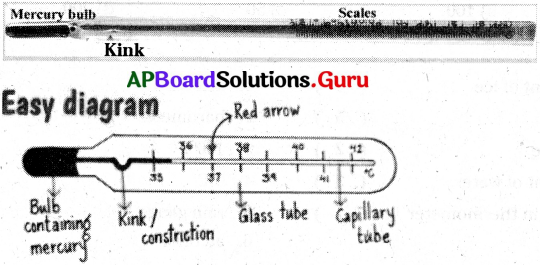
Question 3.
Give two examples for conductors and insulators each.
Answer:
Example for conductors:
Aluminum, iron and copper etc.
Example for insulators:
Water, air, clothes, glass, cork, plastic, wood etc.
Question 4.
Buchhanna thinks that the concepts • weather and climate are the same. Do you agree with him? Justify your answer.
Answer:
I do not agree the Buchhanna’s statement.
- The day-to-day variations in the components like temperature, humidity, rainfall, wind speed are called weather. But, the average weather pattern taken over a long period, say 25 years or more is called the climate of the place.
- Weather keeps on changing and changes are very fast too. But, climate of a place remains unchanged for a long period Of time.
- Rapid changes occur in weather. But no rapid changes occur in climate.
- Weather affects our daily life. But climate affects our lifestyle.
- Weather gives the information about atmospheric conditions in a specific area and time. But, climate gives for a long time of period.
Hence, weather and climate are not the same.
Question 5.
Prepare two questions for a questionnaire for “farmers on climate change”.
Answer:
a) What type of climate changes do you observe in last ten years?
b) What changes have been made in the cultivation of crops due to climate changes?
Question 6.
Give two precautions to be taken while using a clinical thermometer?
Answer:
- Wash the thermometer with water or an antiseptic solution before and after use.
- Before use, the level of mercury should be less than 35°C, otherwise shake it.
- Don’t touch the bulb while taking reading.
- Handle the thermometer carefully, because it is a glass ware.
- Take the reading after increasing of the mercury level is stopped.
![]()
Question 7.
Define conduction. Explain the process of transfer of heat by conduction with your own examples.
Answer:
1) The process of transfer of heat from hotter to colder end through the conductor is called conduction. This mode of transfer of heat happens more in solid conductors.
2) Example 1:
It takes some time for the heat to reach the end of the spatula placed in the cooking vessel. The heat from cooking vessel transfers to the end of the spatula gradually. This type of heat transfer is called conduction.
3) Example 2:
The edges of the steel plate with burning coal burn our hand while holding it. Here the heat transfers from the middle of the plate to the edges gradually.
4) Example 3:
If we put a needle by holding it in the candle flame, it causes burn to our hand. It is due to conduction of heat.
Question 8.
What are the measuring components of weather and explain about them?
Answer:
Maximum and minimum temperature of a day, air pressure, rainfall, wind speed and humidity are called measuring components of weather.
1) Maximum and minimum temperature of a day:
Maximum and minimum tempera-ture of a day are the highest and lowest temperature recorded respectively during a day. Six’s maximum and minimum thermometer is one of the meteorological in-struments used to measure maximum (highest) and minimum (lowest) temperatures of a place in a day.
2) Air pressure:
The force applied by air on any surface in contact is called “air pres-sure”. Air pressure is measured in height of mercury level in centimeters and it is measured with a barometer.
3) Rainfall:
The amount of water falling in rajn within a given time and area is called Rain fall. Rainfall is measured in millimeters by using a rain gauge.
4) Wind speed:
Wind move is caused by difference in the air pressure in two places. The speed of wind can be measured using a device called an anemometer.
5) Humidity:
The water vapour present in the air is called humidity Hygrometer is used to measure humidity in air and it is expressed in grams per cubic meter.
Question 9.
Explain an activity to show that “air experts pressure”?
Answer:

- Take an empty bottle and a balloon.
- Insert the balloon into the bottle.
- Stretch the balloons over the opening of the bottle as shown in the figure.
- Now try to blow air into the balloon inside the bottle.
- But it is not easy to blow air when it is inside the bottle.
- There is some force inside the bottle stopping you to do so.
- This is because the force applied by the air inside the bottle.
- The force applied by air on any surface in contact is called “air pressure”.
Question 10.
Explain the construction and working of six’s maximum and minimum thermometer?
Answer:
- Six’s maximum and minimum thermometer is one of the Meteorological instruments used to measure maximum (highest) and minimum (lowest) temperatures of a place in a day.
- James Six invented this thermometer in 1780.
- It has a cylindrical ‘Bulb A’, and ‘Bulb B’ connected through a ‘U-shaped tube’ con-taining mercury.
- Bulb A contains alcohol, and bulb B c’ontains alcohol and its vapours.
- When the temperature increases, the alcohol in the bulb A expands and pushes the mercury in the U tube, this makes indicator N to move up.
- This indicates the maximum temperature of the day.
- When the temperature decreases, alcohol in the bulb A contracts and pulls the mercury back. This makes indicator M to move up.

- This indicates the minimum temperature of the day.
- After taking readings the indicators M and N are brought to their original places by using a magnet.
7th Class Science 9th Lesson Heat, Temperature and Climate InText Questions and Answers
7th Class Science Textbook Page No. 35
Question 1.
Mention the terms used in the conversation?
Answer:
Heat, cold, weather, temperature, minimum temperature.
Question 2.
What is the difference between Heat and Temperature?
Answer:
Heat flows from a body of high temperature to a body of low temperature . The degree of hotness or coldness is called temperature.
![]()
Question 3.
What is meant by climate of a place?
Answer:
The average weather pattern taken over a long period, say 25 years or more, is called the climate of a place.
Question 4.
Which form of energy help us to cook rice?
Answer:
Heat energy.
Question 5.
Which energy turns the water into vapour, while boiling?.
Answer:
Heat energy.
Question 6.
Why do you feel the heat when you hold a cup of warm milk to drink?
Answer:
We feel hot when heat energy flows from milk to our body. Here we gain heat energy from milk.
Question 7.
Why do you feel cool when you drink a glass of lassi?
Answer:
We feel cool, when heat energy flows from our body to lassi. Here, we lose heat energy.
7th Class Science Textbook Page No. 36
Question 8.
What determines the direction of heat flow?
Answer:
Heat flows from a body of higher temperature to a body of lower temperature. This direction is determined by temperature.
Question 9.
Have you heard about temperature, when you suffer from fever?
Answer:
Yes, I have.
Question 10.
What is temperature?
Answer:
The degree of hotness or coldness is called temperature.
Question 11.
What are the differences between heat and temperature?
Answer:
| Heat | Temperature |
| 1. Heat is a form of energy | It is the degrees of hotness or coldness. |
| 2. It is measured in joules | It is measured in kelvin |
| 3. It has the ability to do work. | It can be used to measure the degree of heat. |
| 4. It flows from hotter bodies to colder bodies. | It increases with increase of heat and decreases with decrease of heat. |
7th Class Science Textbook Page No. 37
Question 12.
Why are cooking utensils made of metals while their handles are made of plastic or wood?
Answer:
- Some materials allow heat through them, this property is called conductivity.
- We use metals to make cooking vessels because they allow heat through them.
- We use material which do not allow heat to pass through as handles.
- So, cooking utensils made of metals while their handles are made of plastic or wood.
7th Class Science Textbook Page No. 38
Question 13.
How does conductors transfer heat energy through them?
Answer:
Heat is transferred in the conductors from one end to another end by the mode of conduction.
Question 14.
How does water transfer heat energy from one place to another?
Answer:
Water transfers heat energy in the mode of convection.
Question 15.
How is heat energy transferred from the Sun to the Earth?
Answer:
Heat energy transferred from the Sun to the Earth in the mode of radiation.
![]()
Question 16.
Many times, Karthik observed that the handle of the spoon becomes hot when it is left for some time in hot oil, hot curry, hot tea or hot milk. Can you guess why does it happen? What is this process called?
Answer:
This is because heat is transferred from one end to another end by the mode of conduction.
7th Class Science Textbook Page No. 39
Question 17.
We know, water is a poor conductor of heat. But, when we heat water on a stove to take a bath, how does the surface of the water get heated?
Answer:
This happens due to the transfer of heat by a mode called convection.
7th Class Science Textbook Page No. 40
Question 18.
What happens if there is no medium (solid, liquid, gaseous substances) to transfer heat between two objects or two places?
Answer:
Heat transfers in the form of waves from one place to another, if there is no medium like solid, liquid, gas.
Question 19.
Recollect the conversation between the three friends Rafi, John, and Satyanarayana at the fire place and can you guess how does the heat energy transfer from the fire place to their bodies?
Answer:
This is because of heat transfer in the form of waves from one place to another.
Question 20.
How does a thermal scanner work, without being in contact with the human body?
Answer:
The thermal scanner receives the heat in the form of radiation to measure our body temperature.
Question 21.
Which instrument can control the transfer of heat (loss of heat)?
Answer:
Thermos flask can control the transfer of heat (loss of heat) and retain hotness of tea for a few hours.
Question 22.
How can we use Thermos flask to stop all modes of heat transfer?
(OR)
Do you know how Thermos flask works?
Answer:
- Thermos flask has a two layered glass container and the air between these layers is removed to create a vacuum.
- The inner silver coating protects the contents (tea, coffee, milk) poured in the flask from losing heat through radiation.
- As there is no medium between the walls of the flask. Neither conduction nor con-vection of heat takes place.
- As a result, heat is not transferred outside the flask so it is retained inside the flask for a few hours.
7th Class Science Textbook Page No. 41
Question 23.
Is it possible to keep the hotness of tea in flask forever?
Answer:
No, gradually a little amount of heat is lost from the lid by convection currents and a small amount of heat by conduction through the glass. Therefore, the tea does not retain heat for a long time or forever.
Question 24.
What changes can we observe in the size of material when it transfers heat energy?
Answer:
We can observe enlarging in the size of material when it transfers heat energy. This is due to increase in the energy of particles present in the substance.
Question 25.
Why are small gaps left between rails in railway tracks?
Answer:
- Particles of substances occupy more space when they get heated.
- In the hot days rails of the railway tracks enlarge (expand) due to heat energy.
- It causes damage to the rails.
- So, small gaps are left between rails in railway tracks.
Question 26.
What change occurs to the level of mercury in thermometer when it is kept in the mouth of a person suffering from fever?
Answer:
The level of mercury in thermometer increases when it is kept in the mouth of a person suffering from fever. This is due to expansion of mercury on heating.
![]()
Question 27.
Why does puri swell when it is put in hot oil?
Answer:
Puri swells when it is put in hot oil, because water in the substance is expanded in the hot oil.
Question 28.
What happens when you heat a piece of metal?
Answer:
When you heat a piece of metal it expands on heating.
Question 29.
Is there any change in the shape and size of a metal?
Answer:
Yes, shape and size changes in the expansion on heating a metal.
7th Class Science Textbook Page No. 42
Question 30.
Do the liquids also expand on heating as solids?
Answer:
Yes
Question 31.
Do gases also expand on heating like solids and liquids?
Answer:
Yes
Question 32.
What happens when air is heated?
Answer:
Gases (Air) expands on heating and occupies more space.
7th Class Science Textbook Page No. 43
Question 33.
How can we use expansion of liquids?
Answer:
We can make devices like thermometers by using the property of expansion of liquids on heating.
Question 34.
What device we use to measure the temperature of a substance and how it works?
Answer:
Thermometers are used to measure temperature, this works on the expansion of liquids (mercury).
Thermometer – roleplay (personification)

Question 35.
How are you?
Answer:
I am fine.
Question 36.
Do you know me?
Answer:
Yes, I know you. You are a thermometer.
Question 37.
Have you ever seen me?
Answer:
Yes, I have seen in my home and hospital.
Question 38.
Try to recall how I look like?
Answer:
You are made of a narrow glass tube with thick walls which is closed at one end and You have a bulb of mercury or alcohol on the other end.
Question 39.
Do you know why mercury or alcohol is used in me?
Answer:
Mercury and alcohol have the best properties to measure temperature.
7th Class Science Textbook Page No. 44
Question 40.
Do you ever observe any marks on Alcohol thermometer? Can you guess what are they?
Answer:
Yes, I observed. Those marks are called scales.
7th Class Science Textbook Page No. 45
Question 41.
How can we use laboratory and clinical thermometers?
Answer:
Using of a laboratory thermometer:
- Place the mercury bulb of the thermometer in a liquid, so that the bulb immerses in it.
- Wait for some time till the mercury level shows a constant reading.
- And take the reading at the level of the mercury.
Using of a clinical thermometer:
- Wash the clinical thermometer properly with an antiseptic solution.
- To lower the mercury level, hold the thermometer firmly and give some jerks.
- Ensure that it falls below 35 °C.
- Now place the bulb of the thermometer under your friend’s tongue.
- After one or two minutes, take the thermometer out and note the reading.
- This is your body temperature.
- Don’t hold the thermometer by the bulb while reading it.
7th Class Science Textbook Page No. 46
Question 42.
What is your friend’s body temperature?
Answer:
98.4°F. (write your friend’s body temperature)
![]()
Question 43.
Why are armpit or part below tongue selected to record temperature?
Answer:
The clinical thermometer is used to determine the temperature of the interior of the body. The part under the tongue is the most accessible area to get accurate interior temperature. So, temperature is taken underneath the tongue. But it is difficult and inconvenient for kids to hold the thermometer under their tongue. So armpit will be used for kids to take body temperature, even though it is not accurate.
Question 44.
Can you tell why smoke always rises up?
Answer:
Smoke and hot air moves up because it expands and becomes lighter.
Question 45.
Why do we have ventilators and exhaust fans on the upper parts of the wall?
Answer:
Smoke and hot air moves up because it expands and becomes lighter. That’s why we have ventilators and exhaust fans on the upper parts of the wall to exhaust hot air and smoke from a room.
Question 46.
What happens at a place, where air expands and rises up?
Answer:
When air expands and rises up it creates a low pressure area.
Question 47.
Who occupies that place which is vacated by hot air?
Answer:
The air high pressure from surrounding to move and occupy that place.
Question 48.
What makes the cooler air come into that place?
Answer:
Low air pressure.
7th Class Science Textbook Page No. 47
Question 49.
Have you ever seen high speed winds blowing over the roofs of houses?
Answer:
Yes.
Question 50.
Is there any relation between these components and the weather of a place?
Answer:
The measurements of components like wind speed, rainfall, temperature etc. in a certain-time and location is called weather.
Question 51.
Do we have any other components of this kind?
Answer:
Yes, humidity is the other components of this kind.
7th Class Science Textbook Page No. 48
Question 52.
Where does this evaporated water go?
Answer:
All the evaporated water from different water bodies go into air.
Question 53.
Do you know what we call this evaporated water present in air ?
Answer:
This water vapour present in the air is called humidity.
Question 54.
What is the role of humidity in sunstroke?
Answer:
- Evaporation of sweat from our body makes us cool to maintain our body temperature.
- In summer, the humidity of air is high.
- Due to high humidity and temperature, it becomes difficult to evaporate the sweat from our body to cool it down.
- But still our body losses water.
- High temperatures, along with humidity sometimes may cause heat stroke or sunstroke.
7th Class Science Textbook Page No. 49
Question 55.
Do all the days have the same values of components of weather?
Answer:
No. All are not the same on all days. This causes variations in atmospheric conditions.
Question 56.
How can we get information of weather at a place?
Answer:
We can get details of weather from weather reports and you can see these symbols on television, newspapers and in weather forecasting.
Question 57.
Have you ever seen the symbols shown in the figure?
Answer:
Yes, I saw it in TV and newspapers.
7th Class Science Textbook Page No. 50
Question 58.
How can we present these components of weather, more effectively?
Answer:
We present these components of weather; more effectively by tabulating these values and by drawing these graph.
Question 59.
Do the climate of a place changes like weather?
Answer:
The climate of a place does not change like weather. Climate of a place remains unchanged for a long period of time.
![]()
Question 60.
What are the measuring components of climate?
Answer:
Temperature, air pressure, rainfall, wind speed and humidity are the measuring components of climate.
Question 61.
Is weather and climate are one and the same?
Answer:
Not the same.
7th Class Science Textbook Page No. 51
Question 62.
What happens if the components of climate changes abnormally?
Answer:
The abnormal variation in the components of climate is called climate change. These variations may affect all parts of the world.
Think & Respond
7th Class Science Textbook Page No. 38
Question 1.
When two ice cubes are placed on wood and aluminium objects with same size which ice cube will melt faster, why?
Answer:
- The ice cube placed on the aluminium object will melt faster.
- Because of aluminium is a good conductor of heat.
- Transfer of heat takes place quickly.
- But wood is a poor conductor of heat and transfer of heat takes place slowly.
Question 2.
Why do animals that live in colder regions have more fur and thick fat layer under the skin?
Answer:
- Animals that live in colder areas have to protect their bodies against extremely cold environmental conditions.
- Their bodies cannot withstand such cold climates.
- So, they have thick white fur on their body.
- This provides an additional layer over their skin.
- Thick white fur acts as insulator of heat and stops the heat transfer from body to outside and vice versa.
- Animals in colder regions have thick layers of fat, because fat acts as an insulator and doesn’t let their body heat escape, which helps them survive in such extreme temperatures.
Question 3.
Why do we wear woolen clothes in winter?
Answer:
As wool is a very good insulator and a poor conductor of heat, woolen clothes keep the body warm and protect it from the cold winds.
Question 4.
Why do most of the desert animals live in burrows (inside soil)?
Answer:
Reptiles, insects and most of the desert animals live in burrows below the surface of the soil or sand to escape the high temperatures at the desert surface.
7th Class Science Textbook Page. No. 39
Question 5.
Why are the Upper layers of water in a pond or a lake hotter than the lower layers during the hot summer?
Answer:
- The heat from the sun is reached to the Upper layers of the lakes first.
- We know that heat transfers in convectional mode in water. .
- Convectional currents take more time to reach the lower layers as there are in deep.
- This means it takes more time to transfer of heat to the bottom of the lake or pond.
- The water of the surface layer is evaporated by absorbing heat and does not heat up quickly.
- As a result heat does not reach the lower layers of the lake. It is another reason.
7th Class Science Textbook Page No. 41
Question 6.
Why the electric power lines (wires) are held loose on poles?
Answer:
- Wire is made up of metal. So, it expands on heating and contracts on cooling.
- If the wire is fixed tightly with maximum tension between two poles, may cut due to contraction on cooling conditions in winter,
- So, the electric power lines (wires) are held loose on poles to minimize the tension in the wires.
![]()
Question 7.
Why are rollers kept under the beams of metal bridges?
Answer:
- Roller supports are commonly located at one end of long bridges.
- This allows the bridge structure to expand and contract with temperature changes and prevents damage.
DO THIS (Page No. 49)
Collect the information about symbols of the weather report and display them in
the classroom.
Answer:
Activities and Projects
Question 1.
Prepare a report by collecting different types of materials in your surroundings and classify them into good and poor conductors based on their conductivity.
Answer:

Question 2.
Visit a veterinary doctor and find out the normal body temperature of domestic animals and birds.
Answer:
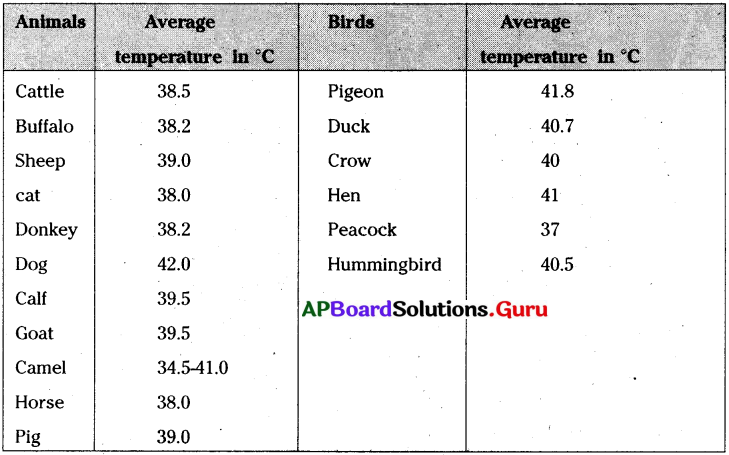
Question 3.
Visit the nearby Tahsildar office or meteorological department office and observe different instruments which are used to measure components and record your ob-servations.
Answer:
| Instrument | Measuring component |
| 1. A thermometer | air temperature |
| 2. A barometer | atmospheric pressure |
| 3. An anemometer | wind speed and the direction the wind is blowing |
| 4. A hygrometer | the relative humidity at a location |
| 5. A ceilometer | determine the height of a cloud base and the aerosol con-centration within the atmosphere. |
| 6. Adisdrometer | the drop size distribution and velocity of falling hydrometers. |
| 7. Rain gauges | the precipitation which falls at any point on the Earth’s landmass. |
Question 4.
Measure the body temperature of atleast 10 of your Mends and prepare a report.
Answer:
Question 5.
Note down maximum and minimum temperature of five consecutive days from today by using 6 minimum and maximum thermometer.
Answer:
Activities
Activity – 1
Question 1.
How do you prove that heat is a form of energy?
(OR)
Write an activity to explain the heat concept.
Answer:
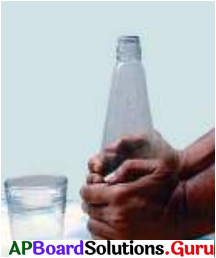
- Take a glass bottle and a one-rupee coin.
- Wet the mouth of the bottle and place a coin on it.
- Rub your hands together to produce heat.
- Now place them around the bottle.
- Observe the coin. It moves.
- Reason:- the movement in the coin is caused by heat supplied to the bottle from your hands.
- Conclusion:-So, we can say heat is a form of energy.
Activity – 2
Question 2.
How do you show the degree of hotness or coldness through an activity?
(OR)
write an activity to understand the concept of temperature.
Answer:
- Take some Iuke-warm water in one glass and hot water (which you can bear) in another glass.
- Touch them and feel the hotness of both.
- Take a glass of cool water and cubes of ice in another glass.
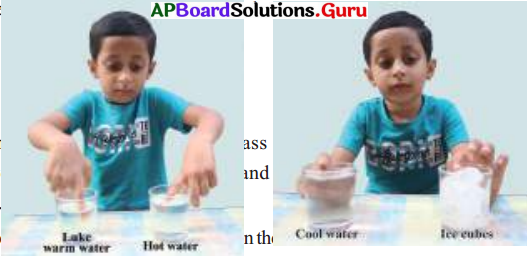
- Touch them feel the coldness of both.
- You will feel hot water is hotter than Luke warm water and ice is cooler than cool water.
- The variations of hotness, coldness can be termed as degree of hotness and coldness.
- The degrees of hotness or coldness is called “Temperature”.
Activity – 3
Question 3.
Write an activity to understand the thermal conductivity.
(OR)
Write an activity to prove that the good conductors allow the heat to pass through them and insulators do not.
Answer:

- Take a glass beaker and pour some hot water in it. mmmd
- Now dip a metal spoon, plastic spoon, wooden stick, glass rod, and long iron nail into it as shown in the figure.
- Wait for few minutes and touch each and every object.
- Fill in the table given below.
| Objects that allows heat | Objects that do not allow heat |
| Metal spoon | Plastic spoon |
| Long iron nail | Wooden stick |
| Glass rod K |
From this activity, you will know that good conductors allow the heat to pass through them and insulators do not.
Activity – 4
Question 4.
Write an activity to show that heat is transferred from one end to another end by the mode of conduction.
(OR)
Write an activity to show the conduction in metals.
Answer:
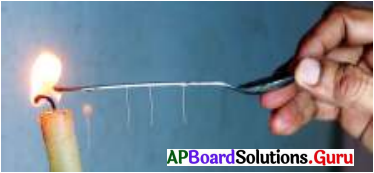
- Take a metal spoon and fix four pins with candle wax on it at equal distances from each other.
- Now place one end of this spoon with pins in a flame of candle holding the other end of it with a piece of cloth.
- Observe for a while. Record your observations.
- You will observe the dropping of pins one after another from the flame end of the spoon.
- This is due to the transfer of heat from the end kept in the flame (hotter end) towards your hand (colder end) through a spoon (metal).
- This process of transfer of heat from hotter to colder end through the conductor is called conduction. This mode of transfer of heat happens more in solid conductors.
![]()
Activity – 5
Question 5.
How can you prove that heat is transmitted by mode of convection in liquids.
(OR)
Write an activity to show the convection in liquids.
Answer:
Aim: To demonstrate the convection of heat in liquids.
What you need:
Round bottomed flask, stand, water, potassium permanganate, straw, candle / spirit lamp.
How to do:
- Take a round bottomed flask and fix it to a stand.
- Now fill this flask with water.
- Wait for some time till this water remains still.
- Gently place some crystals of potassium permanganate in the bottom of the flask by using a straw.
- Now slowly, heat the flask with a lighted candle or spirit lamp and observe carefully.
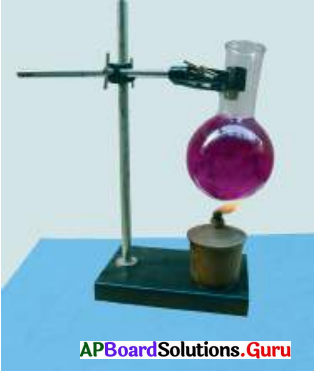
What you see:
- After a few minutes the crystals of potassium permanganate dissolve in water and the coloured water will move up.
- This is because the water at the bottom gets heated and expanded.
- Therefore, water becomes light and moves to the top.
- From the top, cool water comes down through the sides of the flask because it is heavier than hot water.
- This process will continue further.
- So, heat gets transferred from one place (bottom) to another place (top).
What you learn:
This process of transfer of heat from source of heat to surface by the motion of particles is called “convection of heat”. Here heat is transferred by means of currents called convectional currents. In liquids and gases heat is transmitted by mode of convection of heat.
Activity – 6
Question 6.
How can you prove that solid expands on heating and contracts on cooling?
Answer:
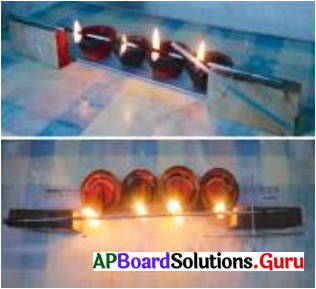
- Take two blocks of wood of same heights.
- Take a cycle spoke.
- Fix one end of the rod to a wooden block with the help of plastic tape, so that it will not move.
- Place the free end of the cycle spoke on another wooden block.
- Take a needle and poke straw to it.
- Place this needle between the spoke and wooden block.
- Place 4 or 5 candles or divas under the metal rod between the blocks and light them.
- Observe the straw carefully.
- You will observe movement in the straw. The needle rolls on the second block of wood because of the expansion of the cycle spoke.
- Now remove the candles or divas and observe.
- If we remove the candles the needle rolls back causing movement in the straw oppo-site to the previous motion.
- From this activity we can say solid expands on heating and contracts on cooling.
Activity – 7
Question 7.
How can you prove that liquids expands on heating?
Answer:
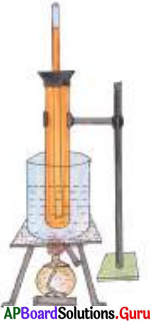
- Take test tube and fill it with coloured water.
- Fix a capillary tube through a rubber cork and mark the level of water on the tube.
- Now put test tube in hot water and observe the level of water in tube.
- Observe the difference in the level of water after heating.
- You will observe raising in the level of water in the tube while heating
- Stop heating and observe change in the level of water again.
- The level of water in the tube lowering while cooling.
- From this you can say that liquids expands on heating and contracts on cooling. (You can use injection bottle instead of test tube and empty refill instead of capilary tube.)
Activity – 8
Question 8.
How can you prove that air expands on heating? What happens when air is heated? Explain with an activity. |i
Answer:

- Take a bottle with a small neck.
- Attach a balloon at the neck of the bottle.
- Place the bottle in a vessel containing water.
- Heat the vessel and observe the size of the balloon care* fully.
- You observe that the balloon will get inflated, because the air inside the bottle gets heated up and expands.
- Now stop heating the bottle and remove it from hot water.
- If needed keep it in cold water and observe the size of the balloon.
- On cooling, you will observe deflation of the balloon.
- Here air contracts on losing heat.
- This activity concludes Gases (Air) expands on heating and occupies more space.
- They contracts on cooling and occupy less space.
![]()
Activity – 9
Question 9.
How can we use laboratory thermometers? Explain with an activity.
Answer:

- Take two bowls.
- Take cold water in one bowl and hot water in another bowl.
- Place the mercury bulb of the thermometer in cold water so that the bulb immerses in it.
- Wait for some time till the mercury level shows a constant reading.
- Note down that reading.
- Now place the thermometer in hot water and note down the tern- perature reading.
- Note down the temperature of the given cold water.
- Note down the temperature of the given hot water.
Activity – 10
Question 10.
How to use a clinical thermometer? Explain with an activity.
Answer:

- Wash the clinical thermometer properly with an antiseptic solution.
- To lower the mercury level, hold the thermometer firmly and give some jerks.
- Ensure that it falls below 35°C.
- Now place the bulb of the thermometer under your friend’s tongue.
- After one or two minutes, take the thermometer out and note the reading.
- This is your body temperature.
- Don’t hold the thermometer by the bulb while reading it.
- Note down the body temperature your friend.
- The normal temperature of the human body is 37°C or 98.4°F.
Activity – 11
Question 11.
How can you explain with an activity, that “On heating, the air expands” occupying more space and becoming lighter?
(OR)
What happens to the air on heating? Explain with an activity.
Answer:
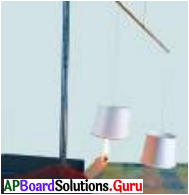
- Take two empty paper cups of the same size.
- Take a broomstick.
- Hang the two cups in the inverted position from the two ends of the broomstick using thread.
- Tie a piece of thread in the middle of the stick. Hold the stick by the thread, like a weighing balance.
- Put a burning candle below one of the cups as shown in the figure and observe what happens.
- We notice that the cup above the candle flame moves up.
- As you already know the phenomenon of convection of heat, the same phenomenon works in air.
- Here the air above the candle gets heated up, becomes lighter and rises up.
- This rising air pushes the paper cup.
- On the other hand, the air under the second paper cup remains the same.
- So, we say that “On heating, the air expands” occupying more space and becomes lighter.
Activity – 13
Question 13.
How do you show that the moving air creates low pressure with an activity?
Answer:
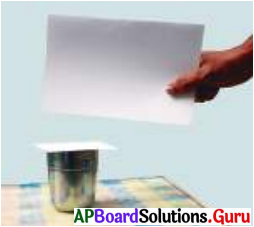
- Take a glass and keep a postcard on it.
- Wave your notebook above the post card to displace the air just above the postcard.
- Observe the post card.
- When we move our note book, there is a movement of air.
- The moving air creates low pressure.
- Hence the postcard lifts up due to the higher pressure on the card from air inside the glass.
Activity – 14
Question 14.
Collect the weather reports of any place (near your village) of the last 7 days from a newspaper or television. Record the information in the table given below.
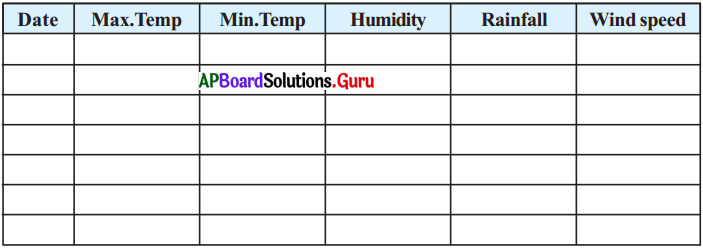
Answer the following questions.
1. What are the measuring components of weather?
Answer:
Maximum and minimum temperature of a day, air pressure, rainfall, wind speed, and humidity are called measuring components of weather.
2. What are your observations? Do all the days have the same values of components of weather?
Answer:
1 observe that some components in the table may be the same for some days. But, all are not the same on all days. This causes variations in atmospheric conditions.
![]()
Activity – 15
Question 15.
Classify the following sentences and write in the table given below.
1) It keeps on changing.
2) Typical weather in a region for a long period of time.
3) It affects our lifestyle.
4) It remains constant for 25 years or more.
5) It affects our daily life.
| Weather | Climate |
| 1. It keeps on changing. | Typical weather in a region for a long period of time. |
| 2. Atmospheric conditions in specific area and time. | It affects our lifestyle. |
| 3. It affects our daily life. | It remains constant for 25 years or more. |
